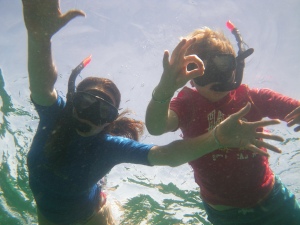By Julie Fison
I love holidays. But I find the planning stage extremely time-consuming and stressful. Will the accommodation be as good as it looks on the web? Have I got the best deal available? Will there be enough to do for the kids when we get there?
The permutations for a perfect holiday are so complicated, the possibility of a disaster so great. And even when I think I have struck on a winning formula my children get older, their tastes change and it’s back to the drawing board (otherwise known as the internet). Holidays are so precious that I want to make them as close to perfect as possible.
But sometimes the elusive X factor can be found in the most unexpected places.
 Last September, after months of planning, I set off with my husband and two sons, aged 11 and 14, along with three other families for a North Queensland driving adventure. The trip had lost its ideal status even before we left.
Last September, after months of planning, I set off with my husband and two sons, aged 11 and 14, along with three other families for a North Queensland driving adventure. The trip had lost its ideal status even before we left.
My older son had been chosen to compete in the Queensland rugby championships in Toowoomba, which meant he and my husband would only be spending three nights in North Queensland. Not great, but not a catastrophe. I could still explore the Far North with my friends and younger son.
However, the holiday didn’t quite work out that way.
While I was swimming with a friend at Four Mile Beach, Port Douglas, a garfish, not much bigger than my index finger, shot out of the water and speared me in the ear. The small intruder left a 2.5 cm spike in my eardrum as a souvenir of its visit, before wriggling free and disappearing into sea
North Queensland is famous for its lethal marine life. Crocodiles, sharks, Irukandji jellyfish are the ones you normally have to watch out for in this part of the world. But garfish?
As it turns out, they are a lot more dangerous than they look. In the Torres Strait bigger garfish periodically spear fishermen, causing all sorts of injuries and in at least one case – death. As far as I can tell, I’m the first to be speared in ear – a very dubious accolade.
Because of my freakishly unlikely and extremely painful encounter, I spent three hours in surgery at Cairns Base Hospital having the spike removed, and the next five days convalescing in Cairns and Palm Cove, instead of exploring the Daintree and Cooktown.
Meanwhile, my son, who had gone further north, fell out of a tree at Cape Tribulation and broke his wrist. My wonderful friends took him to Cooktown Hospital to have his arm manipulated and set in a temporary cast. An eventful holiday to say the least.
To cap things off, I was forced to cancel my flights and take the train home because I had a perforated eardrum. Max and I boarded the Sunlander for the 30-hour journey from Cairns to Brisbane with a couple of magazines, a novel each, and two packets of jubes. I hadn’t even packed any electronic devices
Max had his arm in a sling and I was sporting a facial palsy and was almost completely deaf in one ear. (Yes, quite a pair.) A fitting end to the holiday from hell – right?
Well, not really.
I will certainly concede that Max would have had more fun without a broken wrist and I would have had a better holiday if I hadn’t been speared by a garfish. But at least I had good care in Cairns and had great friends to look after me.
I was sorry I missed out on the Daintree, yet I did have a few lovely memories to take home. We’d all had a great day snorkelling on the reef before the garfish incident and I also managed to enjoy some good meals in Palm Cove and Port Douglas with my friends. And as for the train trip home, I found it quite rewarding.
Normally, I would say that a 30-hour train ride with any number of children (even in a sleeper) is tantamount to torture, but because Max was injured, he was content to read and sleep.
I found just gazing out of the window as the cane farms drifted by and flicking through magazines quite therapeutic (for the first 10 hours anyway). I also had my medication to keep me busy – antibiotics, anti-inflammatories and anti-viral pills to take at various times of the day, along with ear drops and eye drops.
When we needed a break from sleeper-life, we stumbled up to the dining car for a serving of lasagna and over-cooked vegetables, then staggered back for another nap. It wasn’t quite the Orient Express, but it was scenic, relaxing and the kind of experience that doesn’t come along too often.
I wonder how many times I’ll get the chance to hang out with one of my sons for a day and a half without any other distractions – to talk, read and play cards. Probably not too often, is my guess. And if nothing else, that made the holiday very special.
So ten weeks later, my hearing still isn’t great, but my face is almost back to normal. Max has his cast off and it’s holiday time again.
Will it be perfect? Who knows.
Something unexpected always crops up. I know it won’t be a rogue garfish, but there’s bound to be a hitch at some stage. I won’t mind if it’s not perfect, though. I know that just spending time together as a family will make it special and a little bit of adversity can provide unforeseen rewards – that’s what memories are made of.




















